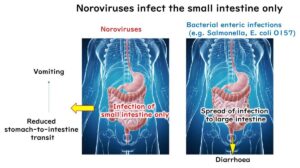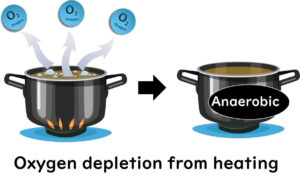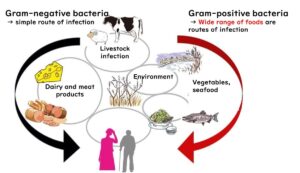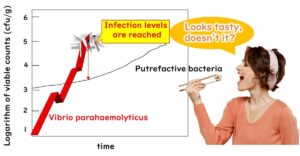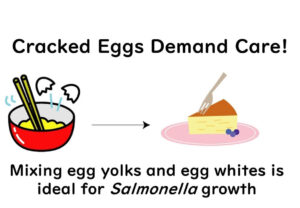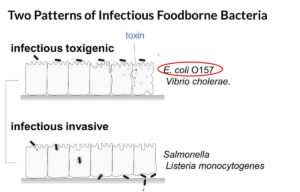Domino Effect: Unraveling the 10 Top Foodborne Pathogens
In this section, we are going to discuss the characteristics and nature of 10 representative foodborne pathogens. These include E. coli O157:H7, Salmonella, Norovirus, Campylobacter, Listeria, Botulinum, Staphylococcus aureus, Vibrio parahaemolyticus, Yersinia, and Bacillus cereus. My explanation will be easy to understand and will focus on the 'why' from the perspective of these microorganisms’ natural habitats, using a domino method of understanding. I’ll avoid overwhelming you with exhaustive knowledge.
Norovirus Explained: Characteristics, Transmission, and Prevention
In this article, we dive deep into noroviruses, uncovering their resilience and the ways they can inadvertently affect food safety. From transmission through food sources to the surprising survival strategies of these viruses, we provide practical insights to prevent norovirus food poisoning.
Clostridium perfringens: Uncovering the Risks of the 'Cafeteria Germ' in Large-Scale Food Poisoning Outbreaks
Clostridium perfringens, known as the "cafeteria germ," is a notorious bacterium responsible for causing food poisoning in large-scale outbreaks. Often lurking in foods like stews and curries that are left to cool slowly, this resilient microbe thrives in warm, oxygen-free environments, making it a significant concern for bulk food preparation in cafeterias, catering facilities, and restaurants. In this article, we delve into the unique characteristics of C. perfringens, its role in foodborne illness, and essential practices to prevent contamination, ensuring safer food handling in high-volume settings.
Understanding Listeria monocytogenes: Risks, Regulations, and Safety Measures in Ready-to-Eat Foods
In this article, we're diving into the world of Listeria monocytogenes, a resilient bacterium responsible for severe foodborne illness, particularly affecting pregnant women, the elderly, and those with weakened immune systems. We'll explore the unique survival abilities of this Gram-positive bacterium, its high fatality rate in foodborne outbreaks, and why it's a primary concern in ready-to-eat foods like deli meats, cheeses, and smoked seafood. Discover the challenges of controlling L. monocytogenes in food production and the differences in regulatory standards between the U.S., EU, and Japan, as we shed light on best practices for keeping food safe from this persistent pathogen.
Exploring Staphylococcus aureus: From Skin Infections to Foodborne Illnesses – A Comprehensive Guide
Welcome to the fascinating realm of Staphylococcus aureus, a bacterium that plays a double role in our lives – both as a harmless skin resident and a potential cause of serious foodborne illness. In this article, we unravel the complex nature of S. aureus, from its habitats on mammalian skin to its infamous enterotoxin, which poses a significant food safety risk. Discover how this opportunistic pathogen operates, its heat-resistant toxins, and the preventive steps food handlers can take to ensure safety. Whether you're studying microbiology or managing food safety, this post sheds light on the critical aspects of Staphylococcus aureus and its impact on health.
Uncovering the Secrets of Clostridium botulinum: From Soil to Deadly Toxin in Our Food Supply
Clostridium botulinum, the bacterium responsible for botulinum toxin, is a fascinating yet alarming subject in the field of food microbiology. Known for producing the most potent biological toxin, this microorganism has raised critical questions for scientists and food safety experts alike. Why does this bacterium produce such a dangerous toxin? How does it survive in everyday foods? This blog dives into the complex nature of Clostridium botulinum, exploring its survival mechanisms, the types of food at risk, and the distinct characteristics between its toxin-producing types. Join us as we unravel the mystery behind this bacterium and its impact on food safety, offering essential insights for professionals and students in microbiology.
Understanding Bacillus cereus: Food Safety Risks and Prevention Strategies
Dive into the hidden world of Bacillus cereus, the unseen but ever-present bacteria lurking in our meals. Discover how it claims its territory, from the unsuspecting corners of your kitchen to the very plate you eat from. Grasp the distinct patterns of food poisoning it orchestrates — some leave you queasy with vomiting, others with relentless diarrhoea. And, uncover the crucial kitchen hack of quick cooling to stop this microscopic menace in its tracks. Are you ready to outsmart the bacteria that loves to spoil more than just your food
The Hidden Dangers of Vibrio parahaemolyticus: Understanding a Marine Bacterium and Food Safety Measures
Exploring the depths of marine life isn’t just about discovering sea creatures; it’s also about understanding the microorganisms that influence our health. Vibrio parahaemolyticus might sound like a complex term, but learning about this marine bacterium is essential. From causing food poisoning to its unique ability to adapt to conditions outside its ocean habitat, Vibrio parahaemolyticus is a marine microbe with terrestrial implications. Discover how Japan’s proactive measures have helped control this bacterium domestically while cases continue to rise globally. Dive into this fascinating exploration of Vibrio parahaemolyticus, where the marine world meets food safety.
Understanding Campylobacter: Food Poisoning Risks and Prevention Tips
Ever had a dodgy chicken sandwich that left your stomach in knots? Or heard of someone feeling numbness after a bout of food poisoning? It might have been down to a little mischief-maker called Campylobacter. In this post, we'll dive into what this bacterium is all about, why it loves to hide in chicken, and some of its peculiar habits like thriving in warm environments and being a bit shy around oxygen. Plus, we'll discuss a mysterious condition called Guillain-Barré Syndrome that might follow this food poisoning – a syndrome where your body's own defense system goes a bit rogue. And, of course, we'll give you some top tips to keep these unwanted dinner guests away from your plate. Ready to become a food safety expert? Let's dive in!
Comprehensive Guide to Salmonella: Understanding Types, Risks, and Food Safety Measures
Salmonella is a bacterium known for causing food poisoning worldwide, but it also has more severe strains that can lead to life-threatening infections. In this article, we explore Salmonella's characteristics, from its habitats and survival traits to its types—those responsible for food poisoning and those that spread through person-to-person transmission. We'll also cover critical aspects of Salmonella's serotype notation, contamination in raw chicken, the latest global regulations, risks associated with eggs, and its unique resilience to drying. Whether you're a food industry professional or a curious reader, this guide provides valuable insights into preventing and managing Salmonella-related risks.
Uncovering Shiga-toxin-producing Escherichia coli (STEC): Infection Mechanisms, Risky Foods, and Long-term Effects
Hello Everyone! I hope you're all well and ready to explore the intriguing world of foodborne pathogens. Over the course of the next 10 lectures, we’ll be delving into individual, representative foodborne bacteria to understand them better. Kicking off our series, we will begin with the Enterohaemorrhagic E. coli, a type of bacteria that can cause serious illness. We'll be discussing its symptoms, incubation period, causes, and routes of transmission, aiming to present the information in a manner that’s easy to comprehend without the need to memorise every detail individually.
